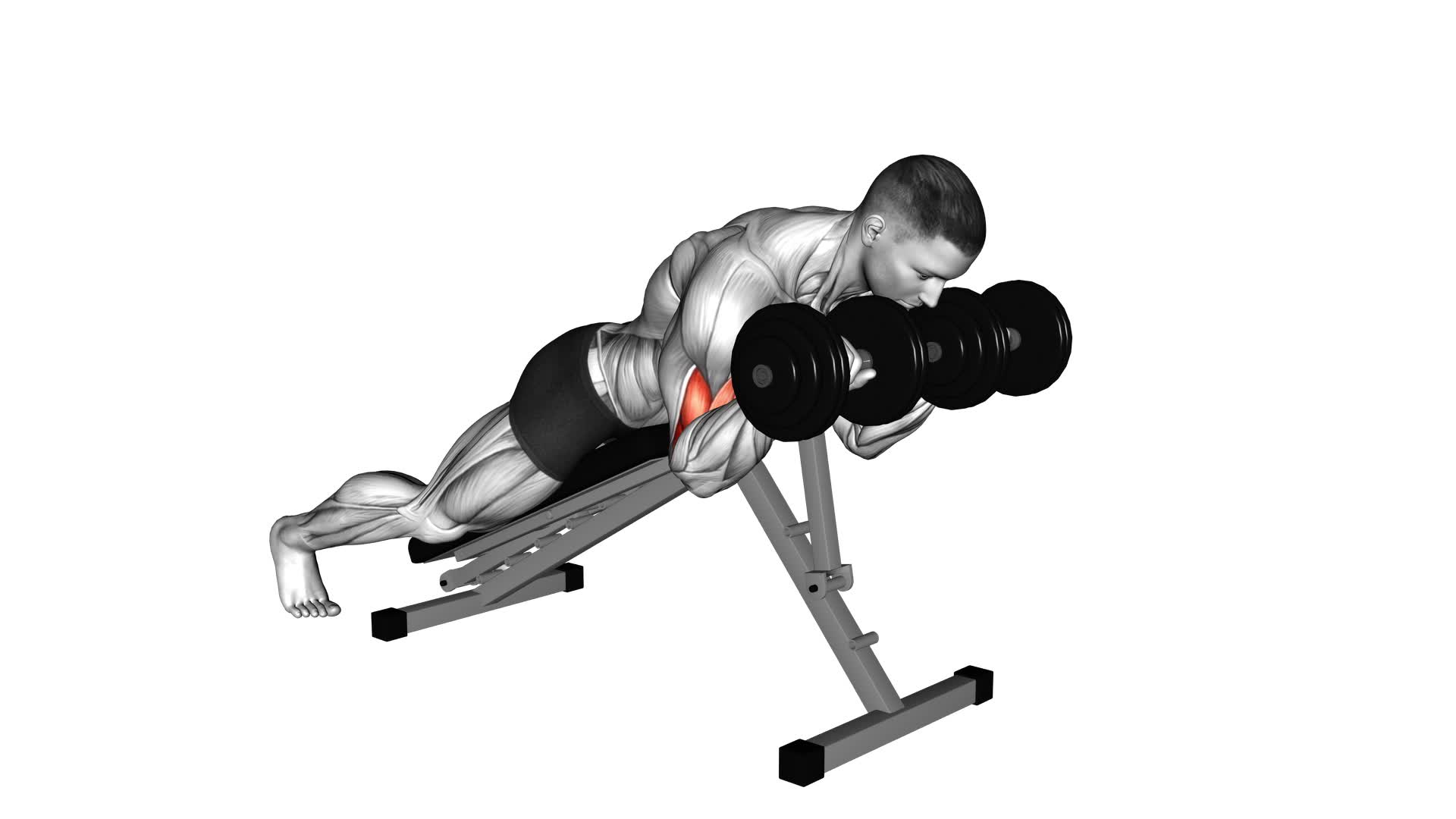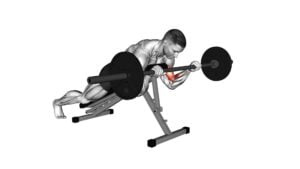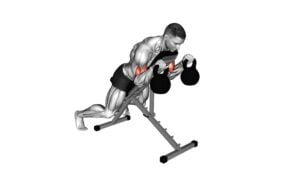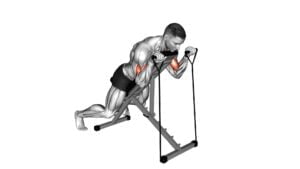Dumbbell Reverse Spider Curl – Video Exercise Guide & Tips

Get ready to target your biceps like never before with the dumbbell reverse spider curl! This exercise is perfect for building strength and definition in your upper arms.
Watch This Exercise Video
In this video exercise guide, we'll show you the proper form and technique, along with common mistakes to avoid. Plus, we'll provide variations and tips to help you maximize your results.
So grab those dumbbells and get ready to sculpt those biceps with the reverse spider curl!
Key Takeaways
- Dumbbell reverse spider curl targets the brachioradialis muscle in the forearm, leading to increased forearm strength and muscle definition.
- Proper form and technique, such as maintaining a 90-degree angle at the elbows and avoiding swinging or using momentum, are crucial for maximum activation of the biceps muscles.
- Selecting the right weight is important to challenge the muscles without compromising form, and gradually increasing weight and incorporating progressions can help in improving strength and preventing injury.
- Dumbbell reverse spider curl offers variations with different grips, allowing for a well-rounded workout that targets the biceps and forearms effectively while minimizing stress on the joints.
Benefits of Dumbbell Reverse Spider Curl
You will experience increased forearm strength and muscle definition with the dumbbell reverse spider curl exercise. This exercise specifically targets the brachioradialis muscle, which is located in the forearm. By incorporating this exercise into your workout routine, you can expect to see significant improvements in the strength and definition of your forearms.
One of the main benefits of the dumbbell reverse spider curl is its ability to isolate and target the brachioradialis muscle. This muscle plays a crucial role in flexing the forearm and is often overlooked in traditional arm exercises. By performing the reverse spider curl, you can effectively strengthen and develop this muscle, resulting in improved grip strength and overall forearm aesthetics.
Another benefit of this exercise is the variety it offers in terms of variations. You can perform the dumbbell reverse spider curl using different grips, such as a pronated (overhand) or supinated (underhand) grip. These variations allow you to target different areas of the forearm and provide a well-rounded workout for your forearms.
Equipment and Setup for Dumbbell Reverse Spider Curl
To properly perform the dumbbell reverse spider curl, you'll need a set of dumbbells and a workout bench. Here is a breakdown of the equipment and setup required for this exercise:
- Dumbbells: Choose a pair of dumbbells that are challenging but manageable for your strength level. The weight should allow you to complete the desired number of repetitions with proper form. Start with lighter weights and gradually increase as you get stronger.
- Workout Bench: Find a workout bench that's sturdy and comfortable. Make sure it's set to a flat or slightly inclined position. This will provide stability and support for your upper body during the exercise.
- Proper Form: To set up for the dumbbell reverse spider curl, follow these steps:
- Stand facing the bench and hold a dumbbell in each hand, with your palms facing downwards.
- Place your upper arms and elbows on the bench, allowing your forearms to hang down perpendicular to the floor.
- Your wrists should be fully extended, with your palms facing the floor.
- Keep your upper arms stationary and curl the dumbbells upwards towards your body, squeezing your biceps at the top of the movement.
- Lower the dumbbells back down to the starting position and repeat for the desired number of repetitions.
Proper Form and Technique for Dumbbell Reverse Spider Curl
To perform the dumbbell reverse spider curl with proper form and technique, it's crucial to pay attention to your elbow positioning. Keep your elbows close to your sides throughout the exercise to ensure maximum activation of the biceps muscles.
Additionally, be mindful of common mistakes such as swinging the weights or using momentum to lift the dumbbells, as this can compromise the effectiveness of the exercise.
Elbow Positioning Importance
Ensure proper form and technique for the dumbbell reverse spider curl by maintaining a 90-degree angle at your elbows. This elbow positioning is crucial for maximizing the effectiveness of the exercise and targeting the desired muscle groups.
Here's why it's important:
- Forearm Engagement: Keeping your elbows at a 90-degree angle ensures that your forearms are fully engaged throughout the movement. This helps to strengthen and develop the muscles in your forearms, improving grip strength and overall arm function.
- Bicep Isolation: Proper elbow positioning allows for better isolation of the bicep muscles. By keeping your elbows stationary and at a right angle, you prevent excessive involvement of other muscles and focus the tension on the biceps, leading to more effective muscle growth and definition.
- Injury Prevention: Maintaining a 90-degree angle at your elbows helps to minimize stress on the joints and reduces the risk of injury. It ensures proper alignment and stability, allowing you to perform the exercise in a controlled and safe manner.
Incorporating dumbbell reverse spider curls into your workout routine with the correct elbow positioning will help you achieve stronger forearms, target your biceps effectively, and prevent injuries.
Common Mistakes to Avoid
To perform the dumbbell reverse spider curl with proper form and technique, avoid these common mistakes.
- First, ensure that your hand placement is correct. Hold the dumbbells with an underhand grip, palms facing up. This will target the brachialis and brachioradialis muscles effectively.
- Another mistake to avoid is improper breathing techniques. Remember to exhale as you lift the dumbbells and inhale as you lower them. This helps stabilize your core and maximize muscle engagement.
- Additionally, be mindful of your elbow positioning. Keep your elbows tucked in close to your sides throughout the exercise to isolate the biceps and prevent strain on the shoulders.
Common Mistakes to Avoid During Dumbbell Reverse Spider Curl
When performing the dumbbell reverse spider curl, it's important to pay attention to your elbow positioning. Make sure that your elbows are kept close to your sides throughout the movement to effectively target the biceps.
Additionally, proper weight selection is crucial to avoid straining your muscles. Choose a weight that challenges you without compromising your form.
Elbow Positioning Importance
Proper elbow positioning is crucial for maximizing the effectiveness of the dumbbell reverse spider curl exercise. When performing this exercise, it's important to pay attention to your elbow positioning to avoid potential mistakes and ensure that you're engaging the right muscles.
Here are three key tips for maintaining proper elbow positioning during the dumbbell reverse spider curl:
- Keep your elbows close to your body: By keeping your elbows tucked in and close to your sides, you can target the muscles in your forearms more effectively. This positioning also helps to prevent unnecessary strain on your wrists.
- Maintain a stable and controlled movement: As you lift the dumbbells, make sure to avoid swinging your arms or using momentum. This will allow you to isolate the muscles in your forearms and maximize their engagement.
- Focus on the contraction at the top: At the top of the movement, make sure to squeeze your forearms and hold the contraction for a brief moment. This will enhance the effectiveness of the exercise and help you build strength in your forearms.
Proper Weight Selection
Choose an appropriate weight that challenges your forearms without compromising your form during the dumbbell reverse spider curl exercise. Proper weight selection is crucial to prevent injury and maximize the effectiveness of this exercise.
To select the right weight, start with a lighter dumbbell and gradually increase the weight as you become more comfortable and confident with the movement. Avoid choosing a weight that's too heavy, as it can lead to poor form, strain on your muscles, and potential injury. On the other hand, using a weight that's too light may not provide enough resistance to effectively target your forearms.
Listen to your body and choose a weight that allows you to perform the exercise with proper technique and control. Remember, it's better to start with a lighter weight and progress gradually rather than risking injury by using too much weight too soon.
Variations and Progressions of Dumbbell Reverse Spider Curl
To progress your dumbbell reverse spider curls, incorporate different weights for added resistance. Here are some variations and progressions you can try to maximize muscle activation and continue challenging yourself:
- Single Arm Reverse Spider Curl: Perform the exercise with one arm at a time. This variation increases the demand on the working arm, allowing for better isolation and control.
- Resistance Bands: Attach resistance bands to the dumbbells and step on them with your feet. This adds constant tension throughout the movement, making it more challenging and effective.
- Eccentric Focus: Slow down the lowering phase of the exercise, emphasizing the negative or eccentric portion. This increases the time under tension and can lead to greater muscle growth and strength gains.
By incorporating these variations, you can target different muscles and stimulate further muscle growth. Remember to start with a weight that challenges you but still allows you to maintain proper form. As you become stronger, gradually increase the weight or resistance to continue progressing.
Now that you know about the variations and progressions of dumbbell reverse spider curl, let's move on to some tips to maximize your results and get the most out of this exercise.
Tips to Maximize Your Dumbbell Reverse Spider Curl Results
For optimal results with your dumbbell reverse spider curl, focus on maintaining proper form throughout the exercise. Proper form is essential for targeting the correct muscles and preventing injury.
One common mistake is using too much momentum to lift the weights. It's important to perform the exercise with controlled movements, focusing on the contraction of the biceps.
Another mistake is using improper weight selection. Choosing too heavy of a weight can compromise your form and lead to improper technique. On the other hand, selecting a weight that's too light may not provide enough resistance to effectively stimulate the muscles.
To find the proper weight, start with a weight that challenges you but still allows you to maintain proper form throughout the entire set. As you become stronger, gradually increase the weight to continue challenging your muscles.
Frequently Asked Questions
How Many Repetitions Should I Do for the Dumbbell Reverse Spider Curl?
To determine the number of repetitions for the dumbbell reverse spider curl, you need to consider your fitness goals and current strength level. Start with a weight that challenges you but allows for proper form.
Perform 8-12 repetitions for muscle growth and strength, or 12-15 repetitions for muscular endurance. Adjust the weight accordingly.
Always prioritize proper technique and listen to your body.
Consult a fitness professional for personalized guidance.
Can I Perform the Dumbbell Reverse Spider Curl With a Barbell Instead of Dumbbells?
Yes, you can perform the dumbbell reverse spider curl with a barbell instead of dumbbells. This variation can provide similar benefits to the dumbbell reverse spider curl, such as targeting the biceps and improving forearm strength.
Using a barbell allows for a wider grip and can increase the challenge on your muscles. However, it's important to ensure proper form and start with lighter weights to avoid any injuries.
Is It Necessary to Warm up Before Doing the Dumbbell Reverse Spider Curl Exercise?
Before jumping into the Dumbbell Reverse Spider Curl, it's crucial to warm up. Warming up helps prepare your muscles and joints for the exercise, reducing the risk of injury. It increases blood flow, flexibility, and range of motion. Skipping warm-up can lead to strains or pulls.
Additionally, it's important to avoid common mistakes like using excessive weight, swinging the arms, or arching the back. Remember, warming up and performing the exercise correctly will optimize your results.
Can I Incorporate the Dumbbell Reverse Spider Curl Into My Bicep Workout Routine?
Yes, you can definitely incorporate the dumbbell reverse spider curl into your bicep workout routine. It's a great exercise that targets your biceps from a different angle and adds variety to your routine.
You can also try incorporating other exercises like regular spider curls or incline curls to further challenge your biceps. By incorporating different variations of spider curl, you can effectively work your biceps from various angles and stimulate muscle growth.
How Often Should I Include the Dumbbell Reverse Spider Curl in My Training Program to See Results?
To see results from the dumbbell reverse spider curl, you need to include it in your training program regularly. The frequency will depend on your overall workout routine and goals.
It's generally recommended to perform this exercise 2-3 times per week with a day of rest in between. Aim for 3-4 sets of 8-12 reps, using a weight that challenges your muscles but allows you to maintain proper form.
This will help you build strength and definition in your biceps.
Conclusion
Overall, the dumbbell reverse spider curl is a highly effective exercise for targeting and strengthening the biceps. By using proper form and technique, you can maximize your results and avoid common mistakes.
Additionally, there are variations and progressions available to challenge yourself as you progress. Adding this exercise to your workout routine can help you achieve stronger and more defined biceps.

Author
Years ago, the spark of my life’s passion ignited in my mind the moment I stepped into the local gym for the first time. The inaugural bead of perspiration, the initial endeavor, the very first surge of endorphins, and a sense of pride that washed over me post-workout marked the beginning of my deep-seated interest in strength sports, fitness, and sports nutrition. This very curiosity blossomed rapidly into a profound fascination, propelling me to earn a Master’s degree in Physical Education from the Academy of Physical Education in Krakow, followed by a Sports Manager diploma from the Jagiellonian University. My journey of growth led me to gain more specialized qualifications, such as being a certified personal trainer with a focus on sports dietetics, a lifeguard, and an instructor for wellness and corrective gymnastics. Theoretical knowledge paired seamlessly with practical experience, reinforcing my belief that the transformation of individuals under my guidance was also a reflection of my personal growth. This belief holds true even today. Each day, I strive to push the boundaries and explore new realms. These realms gently elevate me to greater heights. The unique combination of passion for my field and the continuous quest for growth fuels my drive to break new ground.







